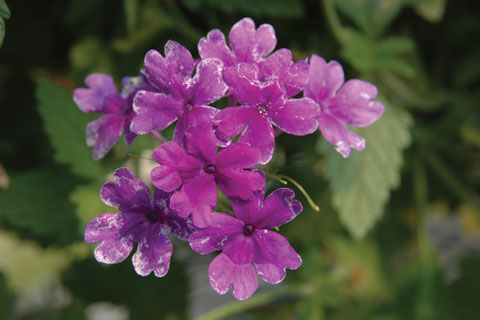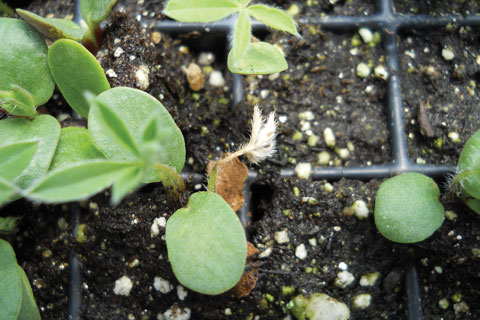2/1/2020
What’s Bugging Your Perennials?
Chris Fifo

Perennial bugs. Perennial diseases. If you think about it, these things really are perennial. They come back year after year. Seasonally and almost predictably. Since we have this information documented from previous years (right?), we have a bit of an edge on managing these pests.
Pictured: Thrips damage on a Phlox paniculata flower.
I’m not going to discuss specific management strategies here, but I am going to do a bit of preaching on the importance of sanitation. You’ve heard it before. You’re going to hear it again.
Keep your place clean! Pick up the junk, clean up the algae, manage the weeds and, by all means, keep lids on the compost cans. Simple things like this can help manage all kinds of pests in perennials. Remember that pests can also overwinter right along with your perennials. Sanitize and sterilize your ground beds at least once a year. This can reduce the chance of spores and larvae coming back in the same spot next year.
Along with sanitation, your scouting program is also the most important aspect in managing pests in your perennials. It’s one thing to be observant of your crop. It’s completely different to have an awareness of your crop. You know what pests to look for, but do you know where? Efficiency is key to an effective scouting program.
Mites
For me, the most difficult pest to find is spider mites. Obviously due to their size, but also because they hide and hot spots often aren’t identified until damage is evident. But if we know our indicator crops it can make it much easier to locate a potential outbreak (Table 1).
Salvia nemerosa is at the top of the list for mites. With the growth habit of the plant, it’s very easy for mites to elude automatic foggers and standard hydraulic spraying. Targeted spraying from multiple angles is needed to lift the leaves for direct contact. Crop maintenance by removing overlapping leaves can also help, but this is obviously labor intensive.
NOTE: Biological controls are very effective in managing mite populations, and are very easy and safe.
The common time of year for mites is the summer in hot and dry conditions. Avoid excessive drought stress on highly susceptible crops.
Table 1. Perennials most susceptible to spider mites.
Salvia nemerosa
Buddleia
Lamium
Potentilla
Fragaria (strawberry)
Geraniums
Scabiosa
Asclepias
Thrips
Thrips are one of the most perennial of pests. Once the weather warms up in the spring, thrips arrive on the jet steam and stay until fall. But they can arrive much earlier, too, coming in undetected on URC. You’ve got to be prepared or they can quickly reproduce in your perennials.
I know of very few perennials thrips don’t like, though there are certainly some they prefer (Table 2). At the top of the list, miles above other crops, would be asclepias. Whether it’s syriaca, incarnata, tuberosa or others, thrips are obsessed with this genera.
Strict management practices must be used if you grow asclepias. Leaf damage can be very evident and flowers can become deformed. The use of sticky cards for monitoring this crop is a must.
For the next level of thrips monitoring and control, some growers are using mass trapping with rolls of sticky tape known as Optiroll. This patented product is colored blue to the wavelength most attractive to thrips, has printed patterns, which attract more thrips, and can be purchased with pheromone impregnated into the glue. It’s scientifically proven to trap more thrips.
Another interesting note: You see in the tables that both mites and thrips LOVE asclepias, though you’ll rarely have both on the same crop. That’s because thrips eat spider mite eggs. (There’s your useful bit of trivia for the day).
Table 2. Perennials most affected by thrips.
Platycodon
Asclepias
Oenothera
Lupines
Grasses-many
Penstemon
Chelone
Aphids
Aphids often seem to me like more of a nuisance pest in perennials. They aren’t exceptionally difficult to kill (usually), but they can sure mess up a crop.
They seem to show up predictably late fall into winter, often coinciding with when plant material for spring finish is coming in. Using the indicator crops (Table 3), they can be easier to find and deal with. I’ve often found aphids get caught in the crossfire of mite or thrips management programs.
Table 3. Indicator crops for aphids.
Aubrieta
Digitalis
Achillea
Dianthus
Veronica
Bellis
Clematis
Overwintering
If you’re overwintering perennials, be aware that all of these pests can overwinter right along with your crop. If you don’t have them under control in the fall, they’ll come out of dormancy in the spring and continue to plague you. Fortunately, in the fall and winter, we’re not as concerned about the flowers and foliage looking nice, so a little phyto or residue from sprays isn’t as big of a deal.
When it comes to overwintering, many growers struggle with losses for all sorts of reasons, the sum of which justifies a book all its own.
Diseases
When it comes to losses from disease, I would have to say the primary cause is Botrytis and the secondary is Rhizoctonia. In the cold, Botrytis doesn’t look like the familiar gray mold we’ve all come to know because it’s not sporulating; it’s more of a white, vegetative fungus. But don’t be fooled—it can be very infectious by growing into the crown unnoticed and decimating your perennials as they sleep.
 Pictured: Fusarium wilt on a lupine seedling.
Pictured: Fusarium wilt on a lupine seedling.
Be aware and protect your perennials as they begin to go dormant. Apply a long-lasting sprench of a broad-spectrum fungicide and watch for reoccurrence of the vegetative fungus. Regular, heavy fungicide sprays may be needed.
As far as other perennial diseases are concerned, there are too many random leaf spots, and crown and root rots to specifically address here. But there are a couple specific perennial diseases I’ve battled regularly.
Fusarium in lupine
This disease always starts where a drop of water sits in the newest leaf. Overnight the leaf can wilt over like a neck wilt on a cut rose. This is your first indication of Fusarium.
Using a leaf blower to remove the water droplet from the foliage (very useful with other crops, too!) helps tremendously. Follow this up with a spray of a strobilurin fungicide, leaving a drop of fungicide where the drop of water was. This is the best protection I’ve found. Preventative only!
Thelaviopsis in aquilegia and viola
Thelaviopsis spores are long lived like perennials—they’re very resilient and are what led me to realize the importance of sterilizing ground beds. These are your two indicator crops. A tremendous amount of information is available for managing this disease. Culturally, the key points are maintaining a crop pH around 5.5 and, as I preached at the beginning of this article …
… keep your greenhouse clean and your perennials won’t bug you as much! GT
Chris Fifo is a Product Representative for Darwin Perennials and Kieft Seed.